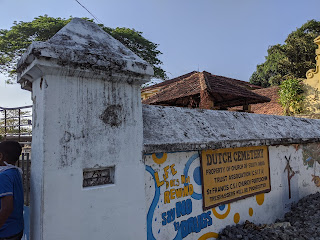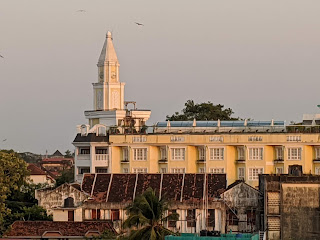Very, very early that day, Steven and I had flown from Sri Lanka to the large southern Indian city of Kochi in the state of Kerala. Our plan had been to stay just a few days in Kochi - aka Cochin - before touring a lot more of Kerala, and then move up to Goa. This was all part of our long planned four-month-long trip to parts of Asia and the Middle East. But of course, all our well-laid plans came to naught almost immediately because of the coronavirus that was just beginning to sweep the world.
After visiting Jewtown, we grabbed a tuk tuk to take us to Fort Cochin's northeastern shore to see the Chinese Fishing Nets, the unofficial emblem of the area and the most photographed.
The Museum, located in the tranquil grounds of the Bishop's House, was also closed.
After visiting Jewtown, we grabbed a tuk tuk to take us to Fort Cochin's northeastern shore to see the Chinese Fishing Nets, the unofficial emblem of the area and the most photographed.
The half-dozen cantilevered nets were a legacy from traders from the court of Kublai Khan circa 1400. The 30-ft. tall contraptions rested on teak or bamboo poles and need half a dozen men to operate their counterweights at high tide.
Not far away was St. Francis Church which had been constructed in 1503 by Portuguese Franciscan friars and was therefore likely India's oldest European-built church. Explorer Vasco da Gama died in Kochi and was buried at the church before his remains were relocated to Lisbon. We were hoping to enter but it was closed unfortunately because of concerns about the virus.
When Steven and I had been wandering around Jewtown, I had felt overwhelmed by all the shopkeepers imploring us to enter their shops and buy, buy, buy. Nothing turns me off more when traveling than that sort of hard sell tactics, much as I may be curious to look at whatever they have for sale. We passed numerous craft shops and vendors in this neighborhood and, much as I was interested in looking at scarves, etc, I just walked on by as it was too overwhelming. I joked with Steven that this Loafer's Corner was my kind of place!
If we didn't know better, it was as if we'd been transported back to Europe when we reached Santa Cruz Basilica which had been built on the site of an early 16th century church. That had been demolished during the city's British era and replaced with this impressive neoclassical Catholic edifice in 1902.
We would have loved to have entered the Indo-Portuguese Museum as I'd read it contained the heritage of one of India's earliest Catholic communities and because it had been established by the Gulbekian Foundation in Lisbon. When we were there less than a year earlier, we'd spent several hours at the Gulbekian Museum and considered it one of the best museums anywhere in the world.
The Museum, located in the tranquil grounds of the Bishop's House, was also closed.
Look at these photos and you, too, would have been equally enchanted as we were walking around Fort Cochin and strolling along lanes called Petrocelli, Elphinstone and Napier. It was hard to realize we were really in India with what we were seeing!
Another sign reminded us to smile as Kerala was God's Own Country!
As David Hall was one of the very few attractions open, we were excited there was actually something to visit that day! Though built around 1665 by the Dutch East India Company, the building acquired its name during the British colonial period. The historic building has been converted into a cultural center with a contemporary art gallery.
The exquisitely restored bungalow was all that remained of a trio of 17th-century houses from the Dutch period built with materials from demolished Portuguese churches.
Immediately on entering the art space, we were required to use a squirt of sanitizer, wash our hands, fill out a lengthy questionnaire about where we had been, where we were staying, and many other personal details.
On top of that, we had to have our temperature taken and recorded on our paperwork before exploring the gallery at all! The entire process was rather daunting, but we had to admire their thoroughness, as nothing like that was happening back home in the US then.
Click on the photo to read why the center was taking such rigorous precautions. We were darned impressed.
The vetting process took longer than it did for us to tour the small gallery, as modern art isn't 'our thing.'
Near the beach was the Dutch Cemetery that had been consecrated in 1724 to hold the graves of Dutch traders and soldiers.
The signs or murals on the exterior walls of the cemetery were very graphic!
By that point we had seen or at least tried to see everything we were interested in in the Fort Cochin part of the city so we just strolled along the waterfront on the Arabian Sea.
The waterfront path wasn't in the same condition as it would have been in Europe, but the views were still sublime, and we had come to India after all, and not Europe.
Imagine living here and looking out at the Arabian Sea when you woke up every day!
This charming seaside abode wasn't too shabby either, needless to say!
We ended up walking all the way back to the Chinese Fishing Nets! We still had no idea how they really worked, but they were intriguing.
Freshly caught fish, anyone?!
This was normal attire for most of the men we saw in this part of town.
I wasn't joking at the beginning of this post when I described the iconic nets as being the emblem of Kochi!
I always leave the negotiating of taxi or tuk tuk fares to Steven when we travel. He worked his magic getting a tuk tuk to take us back to our delightful hotel, the Indy Old Courthouse Hotel.
From the hotel's rooftop pool, we had glorious views of the city's skyline at sunset.
As we'd been up since 4ish to catch an early flight from Sri Lanka and then had a very full day exploring much of Kochi, we turned in early!
Next post: The good and the bad - the fabulous Kerala Folk Museum and our unsettling experience visiting a temple.
If you're looking for something different to read about, here are links to my two most recent and very different posts: discovering ancient Assyria at the British Museum last fall in London and the finale quirky 'life and art during the pandemic post' back home in Denver!
Posted on July 5th, 2020, from Gardiner, Montana, just outside the northern and original entrance to Yellowstone National Park which we'll visit tomorrow for the third day in a row. Please take care of yourself and stay safe.




















































Thanks for introducing me to Chinese fishing nets (apparently also known as shore operated lift nets) and thanks for touring me through Kochi; I , like you , am incredibly impressed with the Covid protocol imposed on you before entering the art museum.... and I love the look of your roof top swimming pool !! xo
ReplyDeleteI had no idea, Lina, that Chinese fishing nets were also known as shore-operated lift nets - thanks for that tidbit of info!
DeleteHugs,
Annie
Here's a link to a youtube video on the operation of the nets https://www.youtube.com/watch?v=Ii81eUj6cXs
ReplyDeleteThanks so much for searching out this video of the history of the nets and how they're operated! Quite fascinating and the whole fishing process makes more sense to me now.
ReplyDeleteAnnie